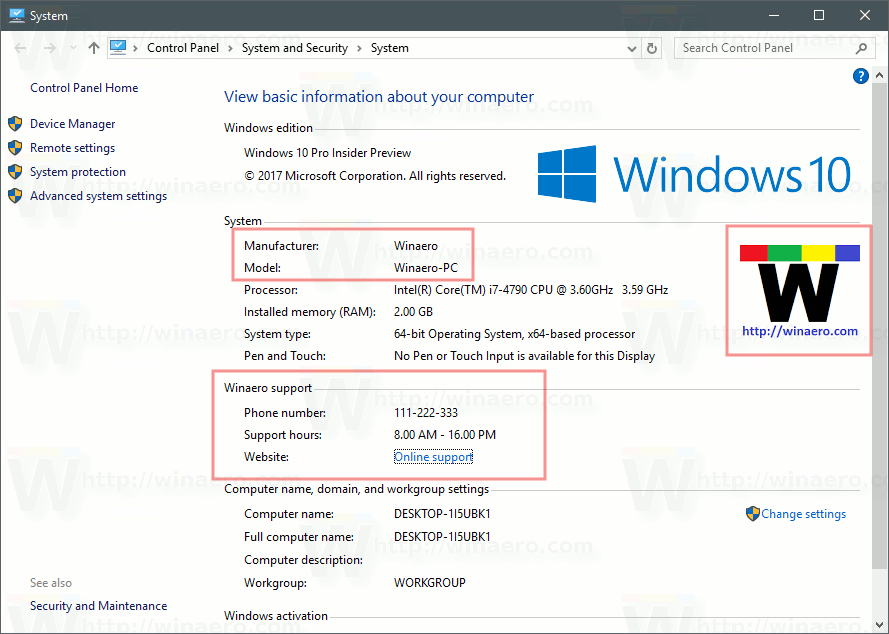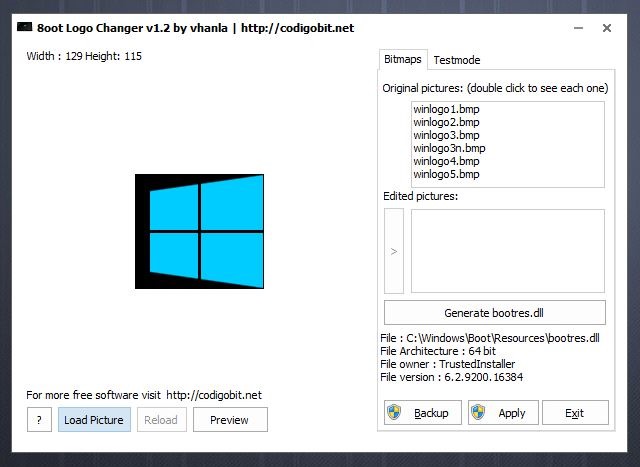OEM Brander enables you to edit this information and to use your own logo, which will be automatically resized and scaled to fit. Unlike most OEM customization tools, OEM Brander supports editing this information on Windows XP to Windows 8 (and future versions if the process does not change). Download System Brand Changer - Change the system logo with a custom image and modify the OEM information in just seconds with this lightweight and portable application.

Windows 10 gives users a great feature to specify the OEM information. You can easily modify and delete it, or add your own — it’s up to you! This can be useful in case you want to give more uniqueness to the machine by displaying your own contact information, your company logotype, URL of website and other values in the System program of Control Panel for single-language, single-region computers.
How to add or modify OEM info in System Properties dialog box?
The instructions below are pretty simple — all you need is to add a few keys in registry. We remind you, that you can do a harm to your computer and it will stop working in case you will make some mistakes in keys settings. Do this on your own risk!

Press Win +R and type in regedit.
After that, go to branch:
HKEY_LOCAL_MACHINESOFTWAREMicrosoftWindowsCurrentVersionOEMInformation
Tip: Since the Windows 10 Creators Update, you can get to folder by pasting a branch name just in the address field.
If the key OEMInformation does not exist, you need to create it. After that you need to create your own list of parameters, using menu Create -> New String Value.
Oem Logo Changer Windows 10
In every string you need to set the Value name and the Value data.
Most likely, in case you are building your own PC, you won’t find any data in OEMInformation string. You are free to set any parameters by using the key names bellow:
- Manufacturer— manufacturer name (for example, Samsung).
- Model— model of PC (for example, Swift 7).
- SupportHours— support hours. Here we need to set time for technical support. For example, 10:00-16:00. You can enter 256 symbols maximum.
- SupportPhone— phone number of technical support. You can enter 256 symbols maximum.
- SupportURL— technical support URL (later the link will be clickable in the dialog box).
- Logo— manufacturer logotype. This one shows the logo in System Properties dialog box. You need to create a desired BITMAP file with 120×120 px maximum dimension and 32-bit color. Place it on the system drive and set the path to file in key value.
If these values are already there, you can delete or modify them in the way you like. After finished, log out of the operating system and then log in again to see if the changes implemented successfully. To do this go to Settings -> About, here check if the new OEMInformation data appeared under Support headline.
Tip: In case you don’t want logging out of the system, you can try to restart Explorer.exe process using Task Manager.
Anytime you boot your Windows computer, the very first thing you see on your screen is the manufacturer’s logo. I don’t know about you but I’ve always wanted to change just about everything on my Windows PC ever since I got the customization flu. The boot logo though is not as easy as changing the wallpaper or even the Windows login screen. The manufacturer doesn’t want you to change the logo. Although, Windows is a pretty popular platform. When a lot of developers have something, somebody will always find a way to change the Windows 10 boot logo. That is how we have this nifty tool called HackBGRT. It lets you change the Windows UEFI boot logo.

Warning
HackBGRT is a little complicated to use. Also, you’re not using it to change wallpapers. Remember, Windows is an OS that might fail to boot when you try as much as installing an icon pack. Changing the UEFI Boot logo is something at another level. It’s our duty to let you know that if you do proceed with using this tool your PC might fail to boot. It is unlikely if you’ve followed the guide below carefully but still very possible. We recommend creating a recovery media first or at least a system restore point. You can create a Windows system restore point and use it to restore your PC.
Dell Oem Logo Windows 10
HackBGRT also creates a backup of the bootloader for such situations. We’ll show you how to use that as well.
Requirements to Chane UEFI Boot Logo
HackBGRT only supports UEFI systems and is not meant to work on anything else. If you’ve bought your computer recently, it is more than likely to support UEFI. If you’re running a dual boot setup, you’re most probably using the Legacy bootloader, in which case you can’t use this tool. You must also make sure Secure Boot is disabled. This can be done in the BIOS menu accessing which is different, depending on the manufacturer of your PC.
Download
Steps to Change Windows 10 Boot Logo
- Download the latest HackBGRT zip from GitHub using the link above and extract the archive.
- In the extracted folder, double-click on the setup.exe file. If your system doesn’t support UEFI or you have it turned off you will be told so in the command prompt window that opens up. Similarly, you will be asked to disable Secure Boot if you have it enabled.
- Hit I on your keyboard to begin the installation. After that is complete the program will open a configuration file in a Notepad.
- In this configuration file, you’ll be required to specify the path to the image file you want to use, the positioning of the image on the screen, etc.
- When you’re done with it, save the configuration file and close it. The default boot logo will then be opened in an MS Paint window. You can edit the image or copy from another source, then save the image in 24-bit BMP format.
- Once the image is saved, the program will make the necessary changes and your boot logo will be applied. You can see the changes when you reboot your system.
How to revert changes
Did something not go as planned? Launch the setup.exe file again and hit D instead of I this time in the command prompt window. There is also the possibility that you might not be able to boot into your system. This is quite unlikely, but we did warn you before. If you did create a recovery media or already had one, you can use that. Or you can use a Windows system restore point that you may have created.
Since you aren’t able to boot into the system, you may still need a bootable Windows media, such as a disc or a USB drive. You can also use the backup created by the HackBGRT tool by copying [EFI System Partition]EFIHackBGRTbootmgfw-original.efi into [EFI System Partition]EFIMicrosoftBootbootmgfw.efi. To do that you will need to use the command prompt from a Windows media or use an Ubuntu Flash drive, etc.
Having applied a custom boot logo on your PC, you might also want to install a custom theme on your Windows 10.